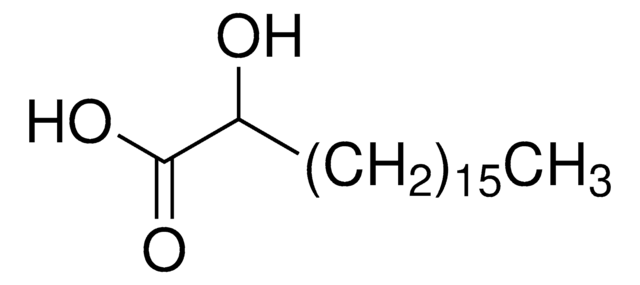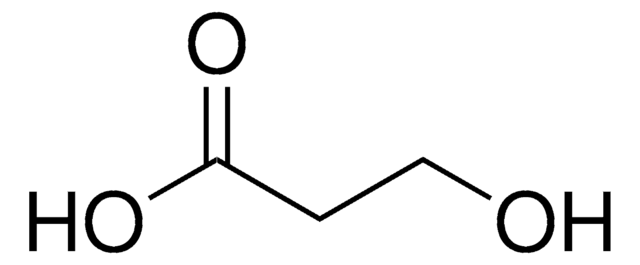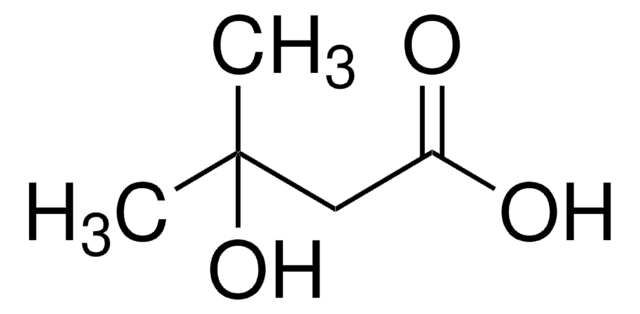H4398
DL-β-Hydroxypalmitic acid
≥98%
Synonyme(s) :
3-Hydroxyhexadecanoic acid
Se connecterpour consulter vos tarifs contractuels et ceux de votre entreprise/organisme
About This Item
Formule empirique (notation de Hill):
C16H32O3
Numéro CAS:
Poids moléculaire :
272.42
Numéro MDL:
Code UNSPSC :
12352211
ID de substance PubChem :
Nomenclature NACRES :
NA.25
Produits recommandés
Niveau de qualité
Essai
≥98%
Forme
powder
Groupe fonctionnel
carboxylic acid
Type de lipide
saturated FAs
Conditions d'expédition
ambient
Température de stockage
2-8°C
Chaîne SMILES
CCCCCCCCCCCCCC(O)CC(O)=O
InChI
1S/C16H32O3/c1-2-3-4-5-6-7-8-9-10-11-12-13-15(17)14-16(18)19/h15,17H,2-14H2,1H3,(H,18,19)
Clé InChI
CBWALJHXHCJYTE-UHFFFAOYSA-N
Actions biochimiques/physiologiques
DL-β-Hydroxypalmitic acid is a mixture of D- and L-β-hydroxypalmitic (3-hydroxyhexadecanoic) acids. 3-hydroxyhexadecanoic [C16:0(3-OH)] may be used in studies that involve the lipid structures of endotoxin lipid A molecules.
Code de la classe de stockage
11 - Combustible Solids
Classe de danger pour l'eau (WGK)
WGK 3
Point d'éclair (°F)
Not applicable
Point d'éclair (°C)
Not applicable
Équipement de protection individuelle
Eyeshields, Gloves, type N95 (US)
Faites votre choix parmi les versions les plus récentes :
Déjà en possession de ce produit ?
Retrouvez la documentation relative aux produits que vous avez récemment achetés dans la Bibliothèque de documents.
Les clients ont également consulté
R P Garg et al.
Molecular microbiology, 38(2), 359-367 (2000-11-09)
In the phytopathogen Ralstonia (Pseudomonas) solanacearum, control of many virulence genes is partly mediated by the Phc cell density sensing system. Phc uses a novel self-produced signal molecule [3-hydroxypalmitic acid methyl ester (3-OH PAME)], an atypical two-component system (PhcS/PhcR), and
P Vadovic et al.
Acta virologica, 51(4), 249-259 (2008-01-17)
The composition and structure of lipid A isolated from the lipopolysaccharide (LPS) of Piscirickettsia salmonis were investigated by chemical analyses, gas chromatography/mass spectrometry (GCMS), and electrospray ionization (ESI) combined with the tandem mass spectrometry (MS/MS). Our study revealed moderate compositional
A Fjellbirkeland et al.
Archives of microbiology, 168(2), 128-135 (1997-08-01)
Membranes obtained from whole-cell lysates of Methylococcus capsulatus (Bath) were separated by Triton X-100 extraction. The resulting insoluble fraction was enriched in outer membranes as assessed by electron microscopy and by the content of beta-hydroxy palmitic acid and particulate methane
Paul J Brett et al.
Molecular microbiology, 63(2), 379-390 (2006-12-14)
Burkholderia mallei, the aetiologic agent of glanders, causes a variety of illnesses in animals and humans ranging from occult infections to acute fulminating septicaemias. To better understand the role of lipopolysaccharide (LPS) in the pathogenesis of these diseases, studies were
M Shinohara et al.
Journal of applied microbiology, 103(1), 152-162 (2007-06-23)
To screen novel micro-organisms and enzymes capable of degrading 3-hydroxypalmitic acid methyl ester (3-OH PAME), the quorum-sensing signal molecule (quormone), which regulates the virulence of Ralstonia solanacearum. Ideonella sp. 0-0013, a betaproteobacterium isolated from soil using the selective-enrichment culture method
Notre équipe de scientifiques dispose d'une expérience dans tous les secteurs de la recherche, notamment en sciences de la vie, science des matériaux, synthèse chimique, chromatographie, analyse et dans de nombreux autres domaines..
Contacter notre Service technique
















